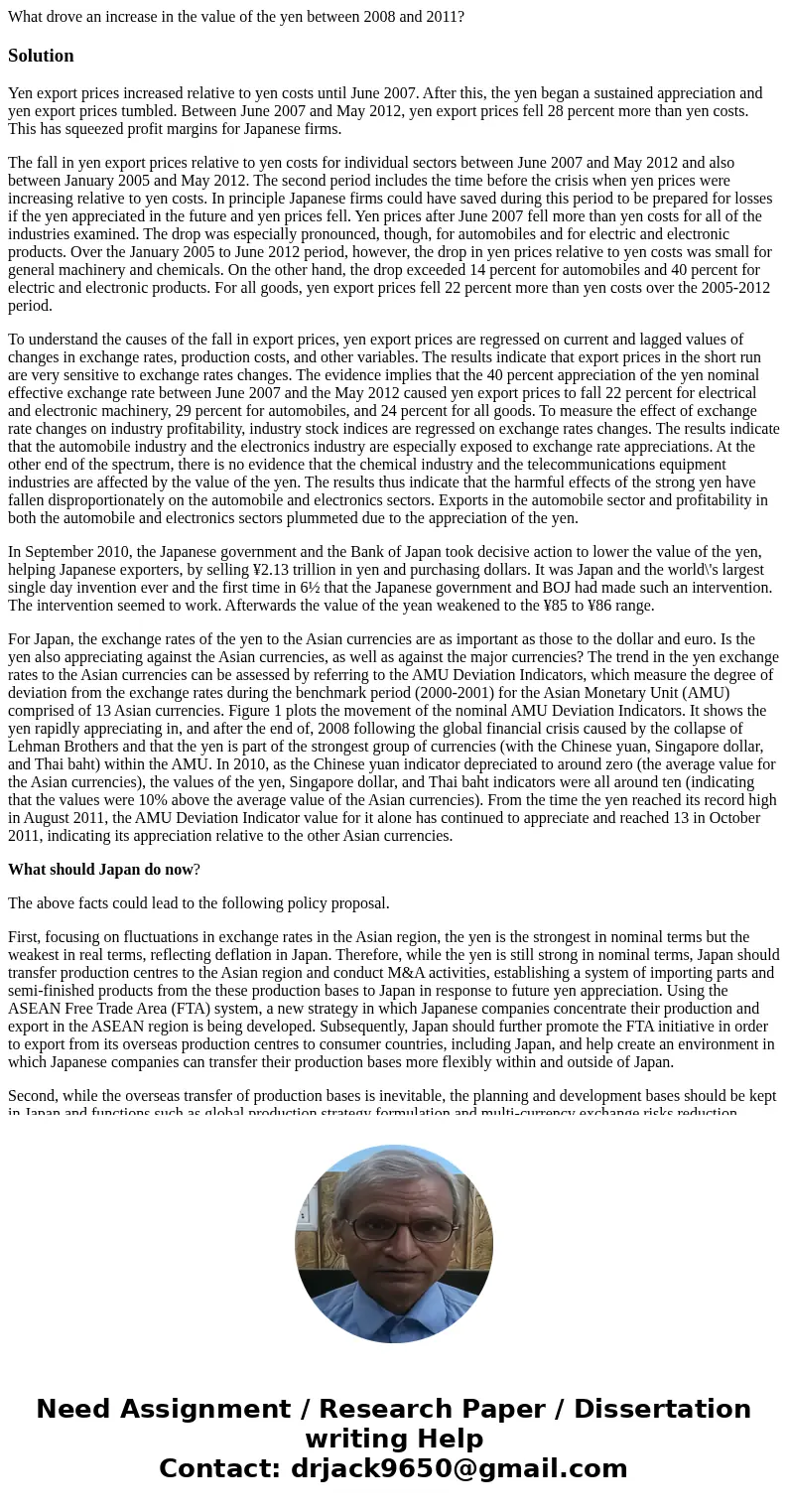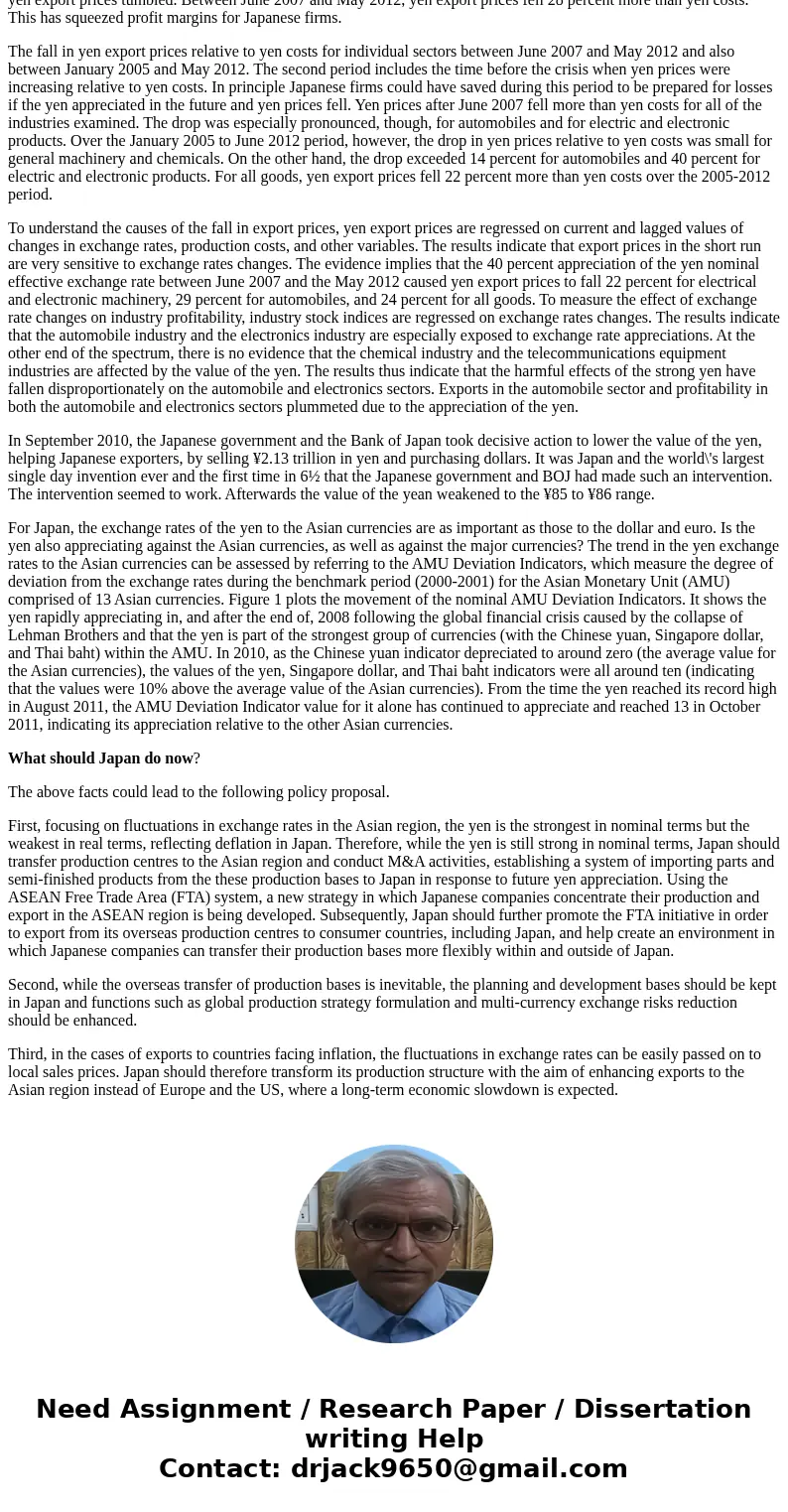What drove an increase in the value of the yen between 2008
What drove an increase in the value of the yen between 2008 and 2011?
Solution
Yen export prices increased relative to yen costs until June 2007. After this, the yen began a sustained appreciation and yen export prices tumbled. Between June 2007 and May 2012, yen export prices fell 28 percent more than yen costs. This has squeezed profit margins for Japanese firms.
The fall in yen export prices relative to yen costs for individual sectors between June 2007 and May 2012 and also between January 2005 and May 2012. The second period includes the time before the crisis when yen prices were increasing relative to yen costs. In principle Japanese firms could have saved during this period to be prepared for losses if the yen appreciated in the future and yen prices fell. Yen prices after June 2007 fell more than yen costs for all of the industries examined. The drop was especially pronounced, though, for automobiles and for electric and electronic products. Over the January 2005 to June 2012 period, however, the drop in yen prices relative to yen costs was small for general machinery and chemicals. On the other hand, the drop exceeded 14 percent for automobiles and 40 percent for electric and electronic products. For all goods, yen export prices fell 22 percent more than yen costs over the 2005-2012 period.
To understand the causes of the fall in export prices, yen export prices are regressed on current and lagged values of changes in exchange rates, production costs, and other variables. The results indicate that export prices in the short run are very sensitive to exchange rates changes. The evidence implies that the 40 percent appreciation of the yen nominal effective exchange rate between June 2007 and the May 2012 caused yen export prices to fall 22 percent for electrical and electronic machinery, 29 percent for automobiles, and 24 percent for all goods. To measure the effect of exchange rate changes on industry profitability, industry stock indices are regressed on exchange rates changes. The results indicate that the automobile industry and the electronics industry are especially exposed to exchange rate appreciations. At the other end of the spectrum, there is no evidence that the chemical industry and the telecommunications equipment industries are affected by the value of the yen. The results thus indicate that the harmful effects of the strong yen have fallen disproportionately on the automobile and electronics sectors. Exports in the automobile sector and profitability in both the automobile and electronics sectors plummeted due to the appreciation of the yen.
In September 2010, the Japanese government and the Bank of Japan took decisive action to lower the value of the yen, helping Japanese exporters, by selling ¥2.13 trillion in yen and purchasing dollars. It was Japan and the world\'s largest single day invention ever and the first time in 6½ that the Japanese government and BOJ had made such an intervention. The intervention seemed to work. Afterwards the value of the yean weakened to the ¥85 to ¥86 range.
For Japan, the exchange rates of the yen to the Asian currencies are as important as those to the dollar and euro. Is the yen also appreciating against the Asian currencies, as well as against the major currencies? The trend in the yen exchange rates to the Asian currencies can be assessed by referring to the AMU Deviation Indicators, which measure the degree of deviation from the exchange rates during the benchmark period (2000-2001) for the Asian Monetary Unit (AMU) comprised of 13 Asian currencies. Figure 1 plots the movement of the nominal AMU Deviation Indicators. It shows the yen rapidly appreciating in, and after the end of, 2008 following the global financial crisis caused by the collapse of Lehman Brothers and that the yen is part of the strongest group of currencies (with the Chinese yuan, Singapore dollar, and Thai baht) within the AMU. In 2010, as the Chinese yuan indicator depreciated to around zero (the average value for the Asian currencies), the values of the yen, Singapore dollar, and Thai baht indicators were all around ten (indicating that the values were 10% above the average value of the Asian currencies). From the time the yen reached its record high in August 2011, the AMU Deviation Indicator value for it alone has continued to appreciate and reached 13 in October 2011, indicating its appreciation relative to the other Asian currencies.
What should Japan do now?
The above facts could lead to the following policy proposal.
First, focusing on fluctuations in exchange rates in the Asian region, the yen is the strongest in nominal terms but the weakest in real terms, reflecting deflation in Japan. Therefore, while the yen is still strong in nominal terms, Japan should transfer production centres to the Asian region and conduct M&A activities, establishing a system of importing parts and semi-finished products from the these production bases to Japan in response to future yen appreciation. Using the ASEAN Free Trade Area (FTA) system, a new strategy in which Japanese companies concentrate their production and export in the ASEAN region is being developed. Subsequently, Japan should further promote the FTA initiative in order to export from its overseas production centres to consumer countries, including Japan, and help create an environment in which Japanese companies can transfer their production bases more flexibly within and outside of Japan.
Second, while the overseas transfer of production bases is inevitable, the planning and development bases should be kept in Japan and functions such as global production strategy formulation and multi-currency exchange risks reduction should be enhanced.
Third, in the cases of exports to countries facing inflation, the fluctuations in exchange rates can be easily passed on to local sales prices. Japan should therefore transform its production structure with the aim of enhancing exports to the Asian region instead of Europe and the US, where a long-term economic slowdown is expected.


 Homework Sourse
Homework Sourse